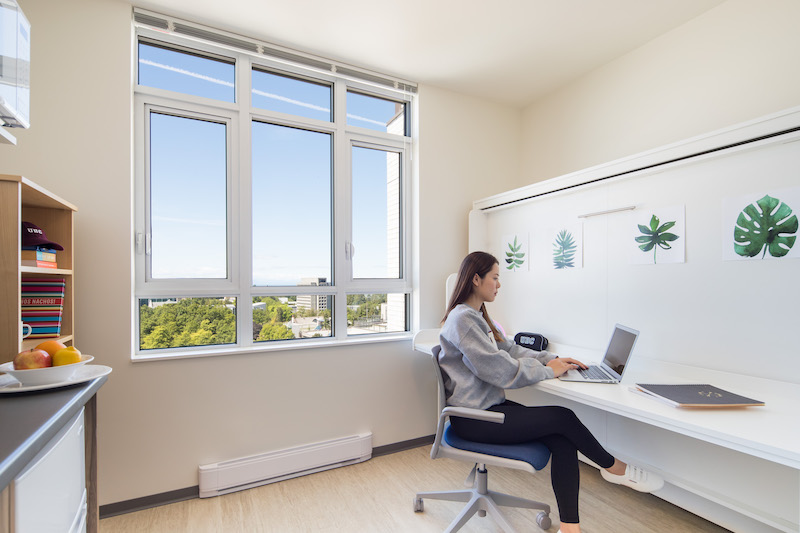Welcome back to part four of the Student Life Series where we discuss strategies for student housing in the COVID-19 era. COVID-19 has already had a dramatic impact on higher education, and only time will tell the continued impacts as colleges and universities prepare for the next school year. What we do know is that student housing will be one of the greatest areas of concern, since this is naturally the area where students have significant, personal contact with one another. At the same time, student housing remains a vital part of the student and campus experience. So we need strategies that protect students, preserve the role of the residence hall, and make sense for the university over the short and long terms.
Recent data about the spread of COVID-19 identifies face-to-face interactions (and respiratory droplet transfer) as the primary means of transmission. This same research shows that the virus does not live long on common surfaces. This leaves student housing professionals and designers to focus on reducing face-to-face interactions and droplet transfer while preserving the residence hall’s vital role in recruitment, social engagement, campus community, and ultimately, student success.
Let’s start with some context. While some institutions may focus on turning double occupancy residential units into single occupancy (creating an optimum social distance), we have to consider the implications of this strategy. Will it increase rental rates while decreasing the university’s available housing capacity (and revenue)? Will it negatively impact first and second year experiences, in which double occupancy rooms are a prime component of the housing experience that is proven to aid in student success? With the growing concerns around higher education’s cost of attendance, student housing and food insecurity, and student debt, we need to be careful about preserving affordability. Alongside these considerations, we have to acknowledge the possibility that many residence halls may be partially or completely empty as some institutions choose to only offer classes online and students opt to stay home. Might this be an opportunity for selective or tactical renovations to address COVID-19 type measures as well as needed facility upgrades? And finally, whatever student housing adaptations we make today, can they also serve as resiliency measures for unforeseen viruses and circumstances of the future?
THE FAMILY UNIT
There is a fairly immediate and inherent challenge with student housing in the COVID-19 era: students living in very close proximity to one another. Short of converting double occupancy to single occupancy units (which some institutions are pursuing), many colleges and universities are suggesting that roommates in shared residential units treat each other like immediate family members, a.k.a. The Family Unit. Outside the unit, they wear a mask and take all necessary precautions. Inside the unit, they can be mask-free and limit their direct exposure to only those peers.
As personal protective equipment (PPE) becomes commonplace, we are hearing interest in “PPE stations”, areas where masks, sanitizer, gloves, and wipes are consolidated for disposal, cleaning, and resupply. These installations may soon be accompanied by “testing stations”, areas where a clean mouth swab can be retrieved and a test sample deposited as institutions attempt to monitor on-campus infection both proactively and discreetly. We have even heard of some businesses incorporating infrared temperature readings at turnstiles or touchless thermometers. While this may seem extreme, it could be the next step in virus detection and prevention at the scale of a residence hall.
SOCIAL DISTANCING FOR THE RESIDENCE ROOM
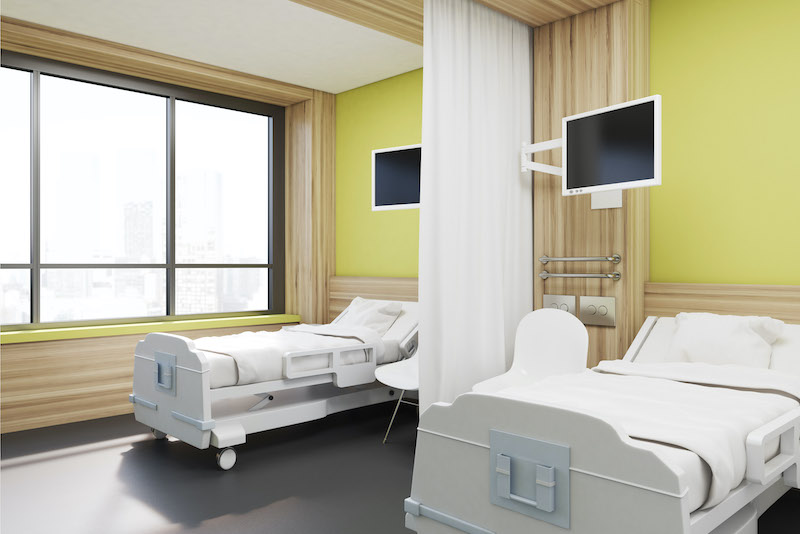 Hospital curtains can be reinterpreted as a flexible way to provide virus protection and individual privacy.
Hospital curtains can be reinterpreted as a flexible way to provide virus protection and individual privacy.
Student housing at many institutions has included a number of design features that could once again prove valuable in the COVID-19 era. Partial or ‘pony’ walls along with strategically placed furniture (like armoires) have been used to create privacy between roommates in the past, and now, these same strategies could provide an important room zoning function. At a recent project, where the design team was asked to adapt a former hospital into a student residence, focus groups noted that the ceiling-mounted curtains wrapping around beds could be saved or reinterpreted as a simple, cost effective, and flexible way to provide individual privacy. In today’s context, this privacy barrier also provides virus protection. We could design these curtains in a more attractive fashion, with color, pattern, and perhaps a clear plastic section for visual connectivity. Now, we have a feature that is protective in the short term and provides privacy and residential character in the long term.
In new construction projects, adding a small sink to a bedroom can allow for a notable decrease in the need for surface cleaning as teeth brushing and more frequent hand washing (another protective measure) are able to be done without leaving the room. Other benefits of a sink in the bedroom include limiting the exposure to community bathrooms and the separation of bathroom fixtures that often allows for greater use among roommates. As yet another benefit, a sink in the bedroom may be particularly attractive to students with religious beliefs that require additional washing, allowing them to more easily and privately do so. Something as simple as the installation of a hand sanitizer dispenser at the room entry door could be another cost-effective solution that we see in hospital and healthcare design.
DON’T LEAVE OUT THE COMMON SPACES
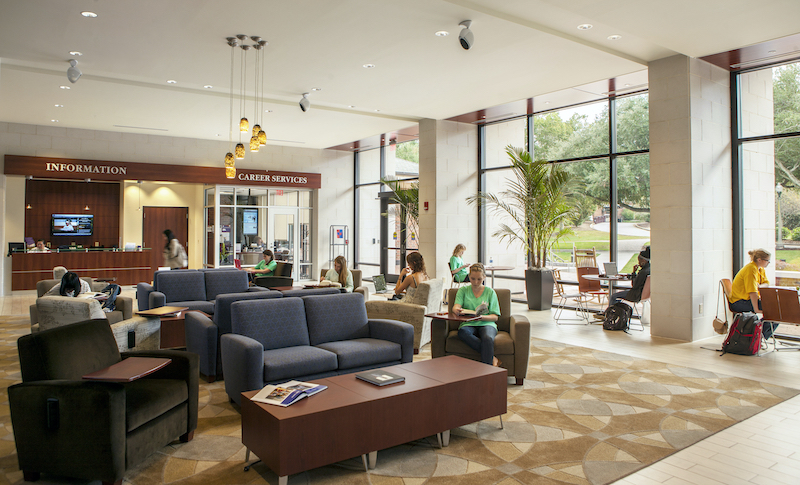 Socially separated common space.
Socially separated common space.
In the COVID-19 era, we would urge colleges and universities to re-design rather than eliminate residence hall common spaces. We know that these gathering areas promote student success in ways that are core to higher education’s mission and are among the most valued features by students. The rethinking of these spaces could include thoughtfully executed social distancing signage and cues that can be adjusted depending on the current circumstances. Think of a six-foot reference today that could be adjusted to more or less tomorrow. We have seen the separation of large spaces into smaller group settings with strategically placed white boards, TV monitors, and furniture arrangements. The furniture itself may adjust with high partitions that give an added layer of virus protection, social separation, and acoustic privacy.
We may even see common spaces used very strategically for distance learning. As universities look to de-densify classrooms, they could set up a residence hall lounge or living room as a remote classroom with live feeds and video chat capabilities. Common spaces could even be used to address the dramatically increasing health concerns (due to COVID-19) and psychiatric counselling demands (pre-existing) on campus by converting small spaces into ‘telemedicine’ chat rooms. As suggested here, the opportunity to pivot common spaces toward flexible, long-term value for students and the institution is significant.
TOUCHLESS ENVIRONMENTS
Even though we are finding that COVID-19 spreads more frequently through face-to-face contact, we know that reducing water droplets through touchless environments can help reduce transmission. Keycard touchpads, automatic front door openers, and elevator card swipes are obvious place to begin (with many of these strategies already in place). Many schools have had interest in keyless, card swipe, or tap room doors but, have been deterred by the cost of installation. Perhaps the cost of installation will come down with a resurgent demand, or institutions will simply view this as a good time to invest. ‘Self-cleaning’ door handle sleeves may be another option here.
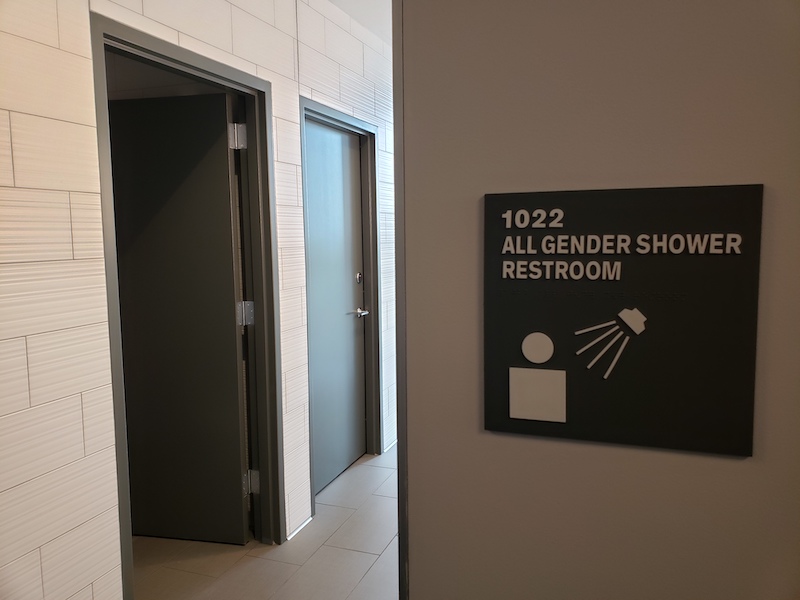 Doorless community bathroom.
Doorless community bathroom.
Bathrooms are the next obvious area for touchless advances. We are all familiar with touchless bathroom fixtures like sinks, toilets, urinals, and hand dryers. But, we may see touchless bathroom entry doors, or the removal of the door altogether, which can be designed to provide privacy, universal access, and gender-neutral options. At the scale of the individual room, we will continue to see the prioritization of occupancy sensors and voice commands tied to lighting and mechanical systems, eliminating these high touch points while helping with energy conservation.
THE AIR WE BREATHE
Another opportunity to safeguard the residence hall environment against the spread of COVID-19 is improving the indoor air quality. One way to do this is to look at mechanical engineering standards typically applied to healthcare environments. These strategies may include increasing the amount of outside air versus recirculating air, upgrading to high-efficiency particulate air (HEPA) filters, creating higher rates of air change that circulate through a given room, and even implementing positive / negative air pressure adjustments that can influence the path of travel of airborne particulates. Residents can even increase the outdoor air supply and natural ventilation of a room with carefully designed window openings, personal fans, and technology that switches off the HVAC system when a window is open. This feature has the long-term benefit of improving energy performance and tracking room occupancy as an added layer of building security.
SINGLE OCCUPANCY AND AFFORDABILITY
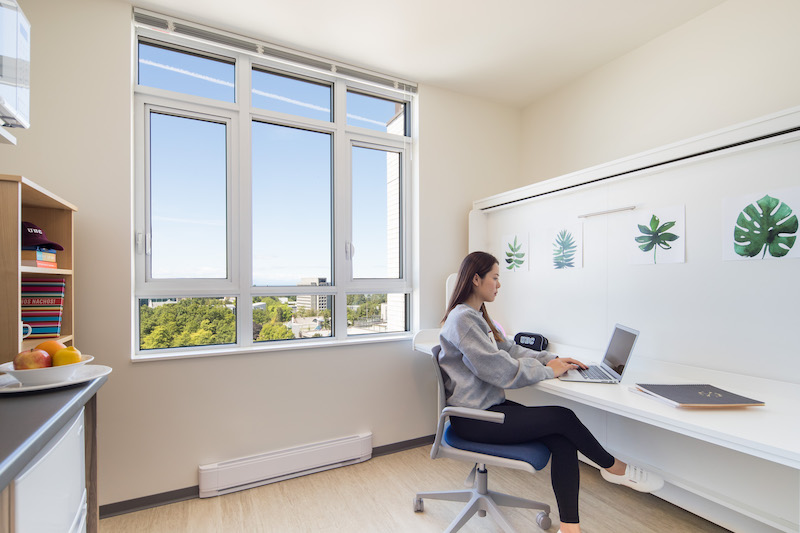
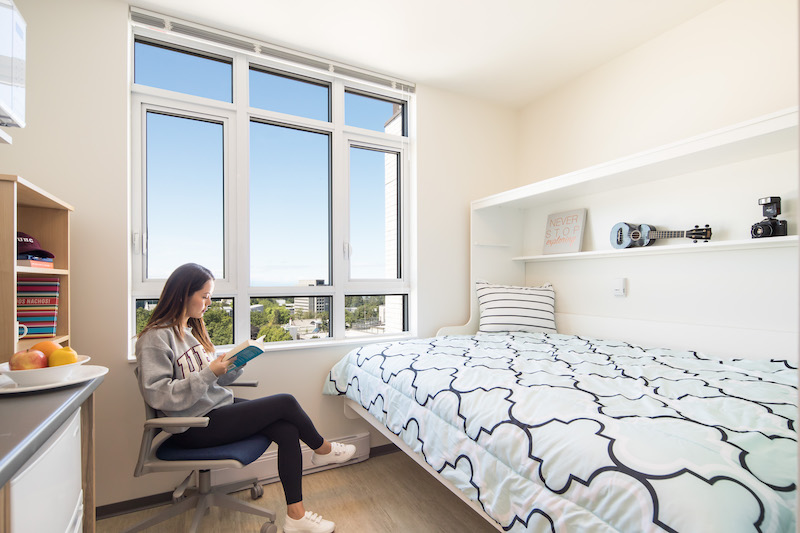 Nano suites at the University of British Columbia in Vancouver, designed by DIALOG.
Nano suites at the University of British Columbia in Vancouver, designed by DIALOG.
If single occupancy is a must, an attractive option for colleges and universities may be micro apartments. New or renovated, single occupancy, micro apartments could serve any student population in the short term (during a virus outbreak), but then be tuned specifically to upperclassmen and graduate students in the long term. There are popular examples of these in Seattle and at the University of British Columbia in Vancouver called “Nano Suites”. A very small studio apartment with a bathroom, furniture that converts from a desk to a bed, and a kitchenette that comes with a small fridge, two element stove, and sink, provides a condensed but affordable living option that can be paired with generous common space. Today, many upperclass and graduate students struggle to find affordable housing close to or on campus in part because of budget constraints, but also, because of the lack of university-owned, upperclass housing. Micro apartment units that offer the privacy and independence of single occupancy along with proximity to main campus, and the affordability of small footprints may have renewed relevance and interest in the COVID-19 era.
We acknowledge that student and staff behavior is perhaps the largest variable in residence hall virus protection. But with careful design strategies, we believe the residential environment can have a significant impact on virus resiliency in the short term and benefit students and the universities they call home in the long term. Thanks for reading and stay tuned for our next article in the Student Life Series.
Related Stories
| Feb 23, 2011
The library is dead, long live the library
The Society for College and University Planning asked its members to voice their thoughts on the possible death of academic libraries. And many did. The good news? It's not all bad news. A summary of their members' comments appears on the SCUP blog.
| Feb 11, 2011
Sustainable features on the bill for dual-building performing arts center at Soka University of America
The $73 million Soka University of America’s new performing arts center and academic complex recently opened on the school’s Aliso Viejo, Calif., campus. McCarthy Building Companies and Zimmer Gunsul Frasca Architects collaborated on the two-building project. One is a three-story, 47,836-sf facility with a grand reception lobby, a 1,200-seat auditorium, and supports spaces. The other is a four-story, 48,974-sf facility with 11 classrooms, 29 faculty offices, a 150-seat black box theater, rehearsal/dance studio, and support spaces. The project, which has a green roof, solar panels, operable windows, and sun-shading devices, is going for LEED Silver.
| Feb 11, 2011
Research facility separates but also connects lab spaces
California State University, Northridge, consolidated its graduate and undergraduate biology and mathematics programs into one 90,000-sf research facility. Architect of record Cannon Design worked on the new Chaparral Hall, creating a four-story facility with two distinct spaces that separate research and teaching areas; these are linked by faculty offices to create collaborative spaces. The building houses wet research, teaching, and computational research labs, a 5,000-sf vivarium, classrooms, and administrative offices. A four-story outdoor lobby and plaza and an outdoor staircase provide orientation. A covered walkway links the new facility with the existing science complex. Saiful/Bouquet served as structural engineer, Bard, Rao + Athanas Consulting Engineers served as MEP, and Research Facilities Design was laboratory consultant.
| Feb 11, 2011
A feast of dining options at University of Colorado community center, but hold the buffalo stew
The University of Colorado, Boulder, cooked up something different with its new $84.4 million Center for Community building, whose 900-seat foodservice area consists of 12 micro-restaurants, each with its own food options and décor. Centerbrook Architects of Connecticut collaborated with Denver’s Davis Partnership Architects and foodservice designer Baker Group of Grand Rapids, Mich., on the 323,000-sf facility, which also includes space for a career center, international education, and counseling and psychological services. Exterior walls of rough-hewn, variegated sandstone and a terra cotta roof help the new facility blend with existing campus buildings. Target: LEED Gold.
| Feb 11, 2011
Chicago high-rise mixes condos with classrooms for Art Institute students
The Legacy at Millennium Park is a 72-story, mixed-use complex that rises high above Chicago’s Michigan Avenue. The glass tower, designed by Solomon Cordwell Buenz, is mostly residential, but also includes 41,000 sf of classroom space for the School of the Art Institute of Chicago and another 7,400 sf of retail space. The building’s 355 one-, two-, three-, and four-bedroom condominiums range from 875 sf to 9,300 sf, and there are seven levels of parking. Sky patios on the 15th, 42nd, and 60th floors give owners outdoor access and views of Lake Michigan.
| Feb 11, 2011
Apartment complex caters to University of Minnesota students
Twin Cities firm Elness Swenson Graham Architects designed the new Stadium Village Flats, in the University of Minnesota’s East Bank Campus, with students in mind. The $30 million, six-story residential/retail complex will include 120 furnished apartments with fitness rooms and lounges on each floor. More than 5,000 sf of first-floor retail space and two levels of below-ground parking will complete the complex. Opus AE Group Inc., based in Minneapolis, will provide structural engineering services.
| Feb 11, 2011
Four-story library at Salem State will hold half a million—get this—books!
Salem State University in Massachusetts broke ground on a new library and learning center in December. The new four-story library will include instructional labs, group study rooms, and a testing center. The modern, 124,000-sf design by Boston-based Shepley Bulfinch includes space for 500,000 books and study space for up to a thousand students. Sustainable features include geothermal heating and cooling, rainwater harvesting, and low-flow plumbing fixtures.
| Jan 21, 2011
Primate research facility at Duke improves life for lemurs
Dozens of lemurs have new homes in two new facilities at the Duke Lemur Center in Raleigh, N.C. The Releasable Building connects to a 69-acre fenced forest for free-ranging lemurs, while the Semi-Releasable Building is for lemurs with limited-range privileges.
| Jan 21, 2011
Nothing dinky about these residences for Golden Gophers
The Sydney Hall Student Apartments combines 125 student residences with 15,000 sf of retail space in the University of Minnesota’s historic Dinkytown neighborhood, in Minneapolis.
| Jan 21, 2011
Virginia community college completes LEED Silver science building
The new 60,000-sf science building at John Tyler Community College in Midlothian, Va., just earned LEED Silver, the first facility in the Commonwealth’s community college system to earn this recognition. The facility, designed by Burt Hill with Gilbane Building Co. as construction manager, houses an entire floor of laboratory classrooms, plus a new library, student lounge, and bookstore.


